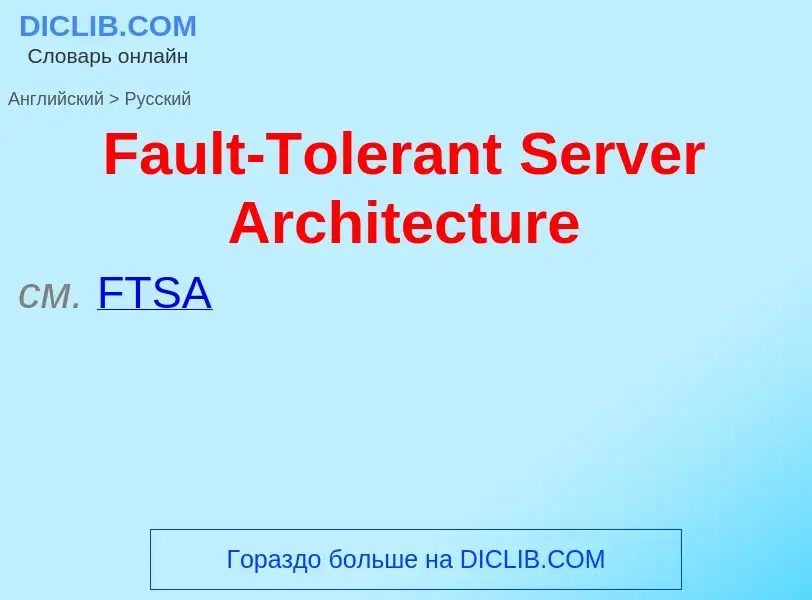Перевод и анализ слов искусственным интеллектом ChatGPT
На этой странице Вы можете получить подробный анализ слова или словосочетания, произведенный с помощью лучшей на сегодняшний день технологии искусственного интеллекта:
- как употребляется слово
- частота употребления
- используется оно чаще в устной или письменной речи
- варианты перевода слова
- примеры употребления (несколько фраз с переводом)
- этимология
Fault-Tolerant Server Architecture - перевод на русский
общая лексика
CSA
архитектура клиент-сервер
широко распространённая двухуровневая модель построения распределённой вычислительной среды, в которой интерфейсная часть задачи (front end) выполняется на машине пользователя, а требующая больших ресурсов обработка запросов (back end) осуществляется одним или несколькими серверами. В чисто программной интерпретации этой архитектуры имеются процессы-клиенты, которые формируют и отсылают запросы на обработку процессу-серверу, возвращающему им результаты. Развитием данной архитектуры являются многоуровневые архитектуры, в которых между клиентом и сервером подключается, сервер приложений (application server)
Определение
Википедия
Fault tolerance is the property that enables a system to continue operating properly in the event of the failure of one or more faults within some of its components. If its operating quality decreases at all, the decrease is proportional to the severity of the failure, as compared to a naively designed system, in which even a small failure can cause total breakdown. Fault tolerance is particularly sought after in high-availability, mission-critical, or even life-critical systems. The ability of maintaining functionality when portions of a system break down is referred to as graceful degradation.
A fault-tolerant design enables a system to continue its intended operation, possibly at a reduced level, rather than failing completely, when some part of the system fails. The term is most commonly used to describe computer systems designed to continue more or less fully operational with, perhaps, a reduction in throughput or an increase in response time in the event of some partial failure. That is, the system as a whole is not stopped due to problems either in the hardware or the software. An example in another field is a motor vehicle designed so it will continue to be drivable if one of the tires is punctured, or a structure that is able to retain its integrity in the presence of damage due to causes such as fatigue, corrosion, manufacturing flaws, or impact.
Within the scope of an individual system, fault tolerance can be achieved by anticipating exceptional conditions and building the system to cope with them, and, in general, aiming for self-stabilization so that the system converges towards an error-free state. However, if the consequences of a system failure are catastrophic, or the cost of making it sufficiently reliable is very high, a better solution may be to use some form of duplication. In any case, if the consequence of a system failure is so catastrophic, the system must be able to use reversion to fall back to a safe mode. This is similar to roll-back recovery but can be a human action if humans are present in the loop.

![clients]] without JavaScript support and/or incompatible browsers until December 2020. clients]] without JavaScript support and/or incompatible browsers until December 2020.](https://commons.wikimedia.org/wiki/Special:FilePath/Twitter M2 mobile website.png?width=200)
![Sun's [[Cobalt Qube]] 3; a computer [[server appliance]] (2002); running Cobalt Linux (a customized version of Red Hat Linux, using the 2.2 Linux kernel), complete with the Apache web server. Sun's [[Cobalt Qube]] 3; a computer [[server appliance]] (2002); running Cobalt Linux (a customized version of Red Hat Linux, using the 2.2 Linux kernel), complete with the Apache web server.](https://commons.wikimedia.org/wiki/Special:FilePath/Cobalt Qube 3 Front.jpg?width=200)
![WWW]] server is located at [[CERN]] with its original sticker that says: "This machine is a server. DO NOT POWER IT DOWN!!" WWW]] server is located at [[CERN]] with its original sticker that says: "This machine is a server. DO NOT POWER IT DOWN!!"](https://commons.wikimedia.org/wiki/Special:FilePath/First-server-cern-computer-center.jpg?width=200)
![rack-mountable]] server with the top cover removed to reveal internal components rack-mountable]] server with the top cover removed to reveal internal components](https://commons.wikimedia.org/wiki/Special:FilePath/Inside and Rear of Webserver.jpg?width=200)
![[[Wikimedia Foundation]] rackmount servers on racks in a data center [[Wikimedia Foundation]] rackmount servers on racks in a data center](https://commons.wikimedia.org/wiki/Special:FilePath/Wikimedia Foundation Servers-8055 35.jpg?width=200)
